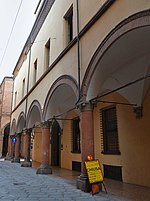Arca di San Domenico
Buildings and structures in BolognaGothic sculpturesMonuments and memorials in BolognaNude sculpturesSarcophagi ... and 1 more
Tourist attractions in Bologna

The Arca di San Domenico (Ark of Saint Dominic) is a monument containing the remains of Saint Dominic. It is located in Dominic’s Chapel in the Basilica of San Domenico in Bologna, Italy.
Excerpt from the Wikipedia article Arca di San Domenico (License: CC BY-SA 3.0, Authors, Images).Arca di San Domenico
Piazza San Domenico, Bologna Galvani
Geographical coordinates (GPS) Address Nearby Places Show on map
Geographical coordinates (GPS)
| Latitude | Longitude |
|---|---|
| N 44.4895 ° | E 11.3445 ° |
Address
Basilica di San Domenico
Piazza San Domenico
40124 Bologna, Galvani
Emilia-Romagna, Italy
Open on Google Maps








